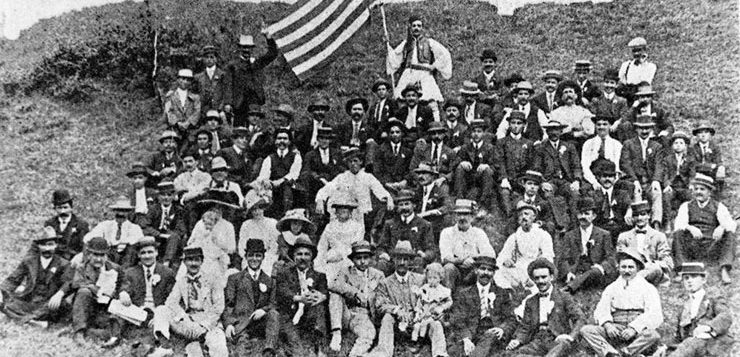Held yearly on 25 March at Melbourne’s Shrine of Remembrance, the Greek Independence Day parade has evolved into a particular representation of Greek-Australian culture. Dr Andonis Piperoglou explains.
Each year, Greek-Melbournians gather to commemorate the Greek War of Independence, acknowledged for restoring democracy (if only fleetingly) to the place where the concept first originated. Priests bless the event and speeches are made by community representatives and consular officials. The repetitive beat of military drums and the weaving of Australian flags alongside Greek flags are ever-present. Youths adorned in provincial folk attire march in unison with their peers and elders. Flower heavy wreaths are laid. This year 12 members of the Athens-based Hellenic Presidential Gard will be participating.
In Greece, ceremonial events on the day operate as symbolic representations of national sovereignty and religious jubilation. The day is a double anniversary -it commemorates the start of the Greek revolutionary war in 1821 and – exactly nine months before Christmas – it is recognised as the Feast of the Annunciation; a moment when Mary was informed that she would be the mother of Jesus. While the day holds religious and national significance in Greece, in Australia the day has become a form of public spectacle.
A multi-generation assortment of Australian, Cypriot, and Greek-born citizens come in their thousands. According to one commentator, the attendance of Greek-Australian youths affirms a commitment to Greek history and the Greek Orthodox tradition in Australia. As the only ethnically orientated event to be held at the public monument the parade holds a special place in the Greek-Australian psyche.
Holding the parade at the Shrine of Remembrance – which architecturally mimics the Tomb of Mausolus at Halicarnassus – reminds attendees that the sacrifices of Australian soldiers have been, and continue to be, compared to the revered heroes of antiquity. The cultural universe of Hellenism is intertwined with the ANZAC mythos. The revolutionary heroes of the Greek War of Independence and the Aussie digger share common ground.
Neos Kosmos, the chief Greek-Australian newspaper, has previously asserted that the parade reveals that the Greek psyche still remains unchanged. Collective emphasis has been placed on the importance of retaining our cultural heritage, our language and our religion. A fear of cultural loss is embedded with a belief in ethnic unity, and the supposed unchanging qualities of Greekness across the generations are flaunted.
A twofold message is presented: first, that Greeks have successfully contributed to Australia; second, that Greek culture embodies a civilizational exemplariness. The blessings, speeches, costumes, flag waving, marching, and subsequent reporting and documenting, creates an image of Greeks as model ethnics. Interestingly, such extroverted symbolism differs from the how some Greek-Australians chose to express their patriotism in the past.
For example, Brisbane-based Greeks held a picnic for Greek Independence Day in 1912. Those who attended, many of whom being early contributors to the Greek-Australian café phenomenon, gathered together on a hillside on the Brisbane River. The picnic points to the settlers’ desire to present and maintain an affinity to both Greece and Australia. Cultural and political distinctiveness is upheld while identification with the spaciousness of the Australian bush appears to be valued.
A subdued process of Greek-Australian cultural becoming is evident. Over the ensuing decades Greek picnics became an integral part of Greek-Australian social life. Today, picnics have largely disappeared from the Greek-Australian social calendar.
Instead, as the well-orchestrated parade at the Shrine of Remembrance suggests, Greek diasporic nationalism is expressed more overtly. People dress as classical deities or revolutionary guerrillas. Through historical references triumphal narratives of Greek culture are presented. The parade has become a site of cultural and social engineering, reaffirming the prodigiousness of Greek civilizational influence. In what historian Ioanna Laliotou calls migrant ‘performative practice’; we could view the Greek Independence Day parade at the Shine of Remembrance as a complex mediation between migration, nation, and culture.
There are many, particularly in the upper echelons of the Greek-Australian community, who assume that Greek history and culture is unquestionably triumphal. Greek attitudes, politics, language, and history are presented as unbroken across the centuries. This is brought home to me on Greek Independence Day when representatives appear to ignore the multiple forms of Greek-Australian culture. They verify Greekness within the predetermined boundaries of Greek nationalism and Australian multiculturalism.
This year, as the Hellenic Presidential Guard march alongside patriotic flag waving Greek-Australians, we should consider: what is to be gained, or lost, by parading one’s ethnicity for public consumption?
Donate To New Matilda
New Matilda is a small, independent media outlet. We survive through reader contributions, and never losing a lawsuit. If you got something from this article, giving something back helps us to continue speaking truth to power. Every little bit counts.




